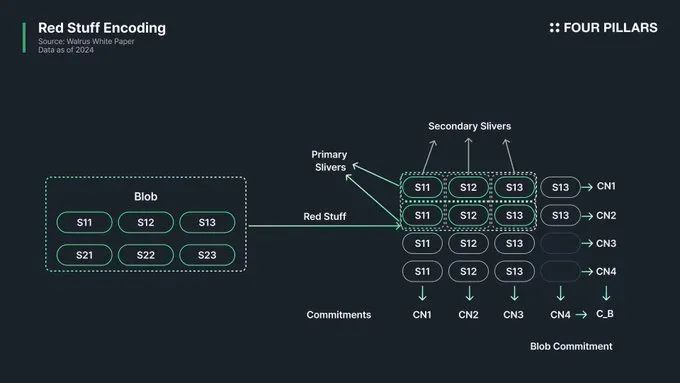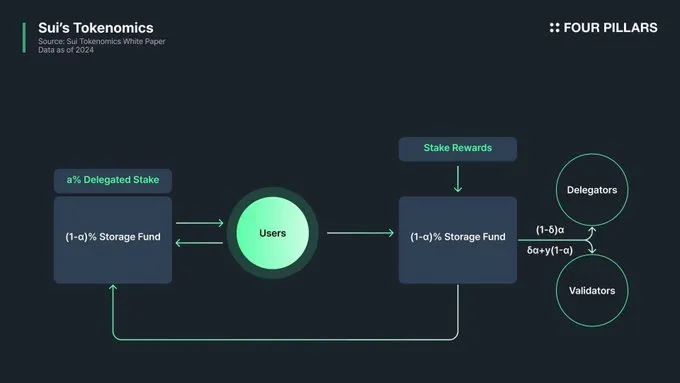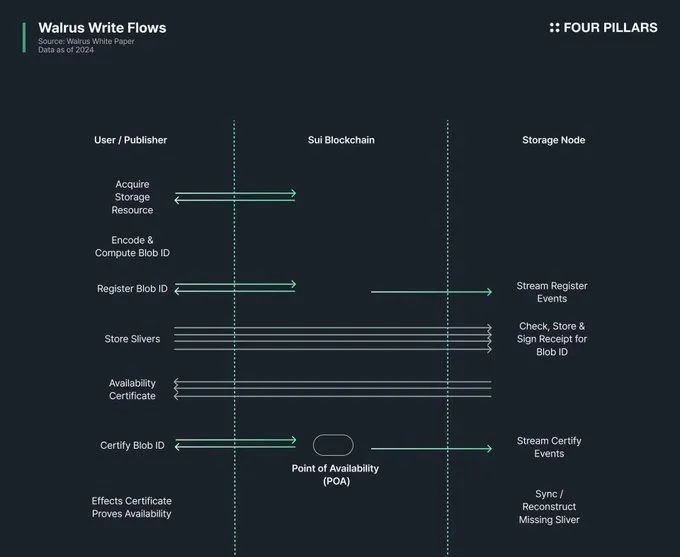Author: @Steve_4P, Four Pillars
Key Points Summary
- Mysten Labs successfully launched the Sui network and DeepBook protocol, and is now preparing to launch a new project - the Walrus protocol.
- Although there are already many decentralized storage protocols in the market, Walrus has attracted widespread attention for the following two reasons:
(1) Cost-effectiveness and security: Walrus is more cost-effective and secure than existing storage solutions;
(2) Programmability: It allows the stored data to be programmed through the Sui network.
- As one of the most advanced projects among existing decentralized storage protocols, Walrus is worth paying attention to for its future practicality and value.
01 Background of Walrus Launch
Mysten Labs has successfully launched the Sui network and DeepBook protocol, and is now venturing into a new field - the Walrus protocol. The success of the Sui network and DeepBook has generated a lot of anticipation for the Walrus project. However, despite the high enthusiasm, there are also some doubts surrounding the Walrus protocol.
These doubts stem from several factors: the market already has many decentralized storage solutions, many of which have not yet reached the ideal performance; and there are also concerns about resource allocation - especially whether Mysten Labs will divert resources due to the need to continue developing and expanding the Sui network, affecting the progress of the new project.
Therefore, we will explore the structure of the Walrus protocol, analyze its differences from existing decentralized storage solutions, and further study the relationship between Walrus and the Sui network, focusing on how Walrus can integrate with the Sui architecture and enhance the value of the entire Sui ecosystem.
1. Differences between Walrus and Existing Storage Solutions
To explain why Walrus needs to exist, we first need to discuss its differences from existing decentralized distributed storage solutions. From my perspective, there are three main differences between Walrus and the existing storage models (especially Filecoin and Arweave):
Storage Cost Efficiency

First, there are significant differences in storage costs between Walrus, Arweave, and Filecoin. As discussed in the Four Pillars article on Walrus, Arweave uses a system where all nodes must replicate and store all data, while Filecoin allows users to decide how many nodes will store their data (users can choose to have only one miner store their data, or distribute 100 pieces of data across 100 miners. Obviously, the more miners required to store the data, the higher the cost).
In contrast, Walrus uses Red-Stuff encoding, demonstrating significantly lower costs than Arweave and Filecoin, with an efficiency up to 100 times higher (compared to Arweave, which requires full network data storage, resulting in up to 500 times replication cost, while Walrus only requires 4-5 times replication). At the same time, the probability of data loss is significantly reduced.
In simple terms, Walrus has solved the shortcomings of Arweave and Filecoin. Arweave has low data loss probability but high replication cost, while Filecoin provides relatively cheap storage based on user needs, but the low-cost option may come with a higher risk of data loss; Walrus, on the other hand, maintains low replication costs while maximizing the reduction of data loss probability, combining the advantages of both.
Furthermore, for Arweave, as the number of nodes increases, the cost also increases (although not linearly), as it encourages all nodes/designated nodes to store as much complete data as possible. In contrast, Walrus only requires a single network data transfer, with each node storing a portion of the data, which actually reduces the burden on individual nodes as the network grows. This structural difference makes Walrus' storage costs significantly more efficient than Arweave and Filecoin.
Programmability
Although the efficiency of Walrus compared to Arweave and Filecoin is very important, the most significant difference between Walrus and the existing storage models is "programmability". Traditional storage is just a simple data warehouse, while Walrus, through the Sui network, has enabled programmable decentralized storage, giving the stored data more functionality.
What if smart contracts could directly reference or trigger data stored in decentralized storage? For example, when minting NFTs, the image files could be stored in Walrus, and their blob data objects could be created on the Sui network, connecting them to the NFT objects. This solves the "incompleteness" problem of traditional NFTs (where NFT tokens are stored on-chain, but the NFT's art metadata is stored off-chain), making NFTs through Walrus true Web3 assets.
Another example directly related to data storage is that since Walrus' blob data can be stored as Sui objects and controlled through Sui's Move smart contracts, smart contracts can transfer the stored data to other users or automatically change ownership. This is why we say the data in Walrus is programmable.
In comparison, Arweave and Filecoin are very limited, if not almost impossible, in their dynamic integration with on-chain applications. Although Filecoin has added some smart contract functionality through the FVM (Filecoin Virtual Machine), the ability to modify and control data is still limited, and Walrus is clearly superior to these two protocols in terms of programmability.
Data Access and Deletion
Existing storage protocols have a characteristic: once data is uploaded, it can be accessed by anyone and cannot be deleted. While this feature may be useful for individual users, it poses great limitations for institutions and enterprises that need to store sensitive data or need to modify/delete data.
In contrast, Walrus allows users to discard or modify their data when needed (which is different from Arweave, where data cannot be deleted or modified; and different from Filecoin, where data deletion is not at the user's active request, but rather when the contract expires or the node hosting the data goes offline).
Some may be concerned that this conflicts with the immutability principle of blockchains, but it's important to remember that in Walrus, it is the blob data that is being deleted. The transaction data unrelated to the blob data remains unchanged, and deleting the blob data does not affect the integrity of the blockchain.
Compared to traditional storage, this enhanced practicality of Walrus greatly increases its application potential in traditional enterprises and Web2 companies, further increasing market expectations for its versatility.
2. Collaboration between Walrus and the Sui Network
After discussing the differences between Walrus and existing storage protocols, let's explore the relationship between Walrus and the Sui network. When Mysten Labs announced that they were preparing to launch the Walrus protocol, many expressed skepticism, believing that "they should focus on Sui, rather than creating another new protocol". However, with a basic understanding of how Walrus operates, it becomes clear that Walrus is not distracting from Sui, but rather should be seen as a storage stack aimed at enhancing applications on Sui. In other words, Walrus not only complements the Sui network from a storage perspective, but also actively influences the governance token SUI of the Sui network, making the two inseparable. Let's explore this further.
The Symbiotic Relationship between Sui and Walrus
In fact, Mysten Labs has been very focused on storage issues since the early design stage of Sui. As blockchains inevitably grow in usage, this could lead to increased transaction fees for future Sui network users. Therefore, from the early design stage of Sui, Mysten Labs proposed a unique storage fund concept to address Sui's storage challenges.

The Sui storage fund operates as follows: the fees submitted by users to Sui validators are divided into two parts: 1) Gas fees related to computation, and 2) Storage fees for data storage. Sui pre-collects storage fees when users upload data and deposits these funds into the storage fund. The storage fund will then continuously allocate these funds to the validation nodes as long as the data remains stored on-chain. Furthermore, if users delete data, they can receive a refund of the storage fees.
Sui's unique on-chain data storage system has two effects:
Users can receive a refund of storage fees when deleting on-chain data, creating an economic incentive to reduce the distributed ledger capacity.
This system solves the sustainability issue of storage-related costs by pre-collecting storage fees and using them as future rewards for validation nodes.
 Furthermore, Walrus has achieved the most distinctive feature compared to other storage protocols through Sui - making the stored data programmable and controllable. Ultimately, Sui and Walrus have established a symbiotic relationship, complementing each other's shortcomings and creating unique advantages.
### **Walrus Makes SUI a Deflationary Asset**
From the example of the storage fund, we can see that the Sui network requires a certain amount of SUI to be paid as storage fees for storing any object, and Walrus is no exception. When creating blob data objects in Walrus, SUI will be locked in the storage fund based on the size of the object (referring to the size of the object representing the blob, not the actual size of the blob).
Although a portion of the fees can be refunded by deleting the data, a part of the fees will have a burning effect, permanently removing tokens from circulation. In other words, the more data is stored through Walrus, the more SUI will be permanently locked in the storage fund, forming a virtuous cycle where the increased use of Walrus leads to a decrease in the circulation of SUI.
In summary, the emergence of Walrus is a positive news for the Sui network, both at the network level and the asset level. It is expected that through Walrus, the Sui ecosystem will develop in a more diversified direction.
## 02 Walrus Will Become the Most Critical Protocol for Sui
### **1. Not Just Building a Blockchain**
When Mysten Labs was first established, I thought it was just a company focused on the Sui network. However, after seeing the launch of services like Deepbook and SuiNS, I started to ponder what kind of vision Mysten Labs was pursuing. When I encountered Walrus, I realized that their goal is to build a complete Web3 decentralized infrastructure.
Compared to other companies, Mysten Labs has a different time horizon when it comes to viewing this industry. They are not just issuing tokens, generating hype, and quick monetization; instead, they have a vision to lead innovation in various fields such as execution, storage, consensus, and communication, while also understanding the inertia of users towards Web2 services and creating the most suitable UI for them.
The Sui network handles execution and consensus (constantly evolving through plans like Mysticeti, Pilotfish, and Remora), storage is handled by Walrus, communication is handled by SCION (a next-generation internet architecture known for its DDoS protection and immune routing attacks - it's worth noting that SCION was not created by Mysten Labs, but it will be applied to the Sui network), and Web2-familiar UI is managed by zkLogin, Stashed, SEAL, and KELP.
If all these plans can be successfully implemented, I believe Mysten Labs can rewrite the existing Web3 paradigm. My initial idea was limited, as Mysten Labs is not just building a blockchain - they are a team building infrastructure for a new network. Of course, I believe Sui is at the core of Mysten Labs' vision, and the other plans are playing a complementary role. Walrus is also like this, and in my opinion, Walrus may be the most important protocol among them.
### **2. Walrus Not Limited to Sui Ecosystem**
However, Walrus is not limited to the Sui ecosystem. Like other storage protocols, Walrus can be used by any third party, not just Sui applications. It may even serve as a powerful alternative to existing storage protocols or as an alternative solution for other DA layers (such as Celestia, EigenDA, Avail).
This availability of Walrus expands the demand for SUI beyond the Sui network. When Walrus is used, data objects will be created on the Sui network, leading to a reduction in the circulation of SUI. In other words, Walrus has the potential to make SUI a more attractive asset by creating external demand (this is not investment advice, but a structurally possible scenario). Therefore, Walrus is expected to become a bridge that expands Sui in various directions.
### **3. Can Walrus Surpass Filecoin?**
While caution is needed when comparing the value of specific protocols, I am very optimistic about the future of Walrus because: 1) its operating mechanism is much more efficient than existing storage protocols, 2) it can perform tasks that current storage protocols cannot (such as becoming a DA or making stored data programmable), and 3) it already has a solid network and user base through the Sui network.
If Walrus is not just the storage layer for the Sui network, but becomes the representative storage protocol for Web3 as Mysten Labs envisions, it has the potential to become the leading protocol in the storage domain.
Furthermore, Walrus has achieved the most distinctive feature compared to other storage protocols through Sui - making the stored data programmable and controllable. Ultimately, Sui and Walrus have established a symbiotic relationship, complementing each other's shortcomings and creating unique advantages.
### **Walrus Makes SUI a Deflationary Asset**
From the example of the storage fund, we can see that the Sui network requires a certain amount of SUI to be paid as storage fees for storing any object, and Walrus is no exception. When creating blob data objects in Walrus, SUI will be locked in the storage fund based on the size of the object (referring to the size of the object representing the blob, not the actual size of the blob).
Although a portion of the fees can be refunded by deleting the data, a part of the fees will have a burning effect, permanently removing tokens from circulation. In other words, the more data is stored through Walrus, the more SUI will be permanently locked in the storage fund, forming a virtuous cycle where the increased use of Walrus leads to a decrease in the circulation of SUI.
In summary, the emergence of Walrus is a positive news for the Sui network, both at the network level and the asset level. It is expected that through Walrus, the Sui ecosystem will develop in a more diversified direction.
## 02 Walrus Will Become the Most Critical Protocol for Sui
### **1. Not Just Building a Blockchain**
When Mysten Labs was first established, I thought it was just a company focused on the Sui network. However, after seeing the launch of services like Deepbook and SuiNS, I started to ponder what kind of vision Mysten Labs was pursuing. When I encountered Walrus, I realized that their goal is to build a complete Web3 decentralized infrastructure.
Compared to other companies, Mysten Labs has a different time horizon when it comes to viewing this industry. They are not just issuing tokens, generating hype, and quick monetization; instead, they have a vision to lead innovation in various fields such as execution, storage, consensus, and communication, while also understanding the inertia of users towards Web2 services and creating the most suitable UI for them.
The Sui network handles execution and consensus (constantly evolving through plans like Mysticeti, Pilotfish, and Remora), storage is handled by Walrus, communication is handled by SCION (a next-generation internet architecture known for its DDoS protection and immune routing attacks - it's worth noting that SCION was not created by Mysten Labs, but it will be applied to the Sui network), and Web2-familiar UI is managed by zkLogin, Stashed, SEAL, and KELP.
If all these plans can be successfully implemented, I believe Mysten Labs can rewrite the existing Web3 paradigm. My initial idea was limited, as Mysten Labs is not just building a blockchain - they are a team building infrastructure for a new network. Of course, I believe Sui is at the core of Mysten Labs' vision, and the other plans are playing a complementary role. Walrus is also like this, and in my opinion, Walrus may be the most important protocol among them.
### **2. Walrus Not Limited to Sui Ecosystem**
However, Walrus is not limited to the Sui ecosystem. Like other storage protocols, Walrus can be used by any third party, not just Sui applications. It may even serve as a powerful alternative to existing storage protocols or as an alternative solution for other DA layers (such as Celestia, EigenDA, Avail).
This availability of Walrus expands the demand for SUI beyond the Sui network. When Walrus is used, data objects will be created on the Sui network, leading to a reduction in the circulation of SUI. In other words, Walrus has the potential to make SUI a more attractive asset by creating external demand (this is not investment advice, but a structurally possible scenario). Therefore, Walrus is expected to become a bridge that expands Sui in various directions.
### **3. Can Walrus Surpass Filecoin?**
While caution is needed when comparing the value of specific protocols, I am very optimistic about the future of Walrus because: 1) its operating mechanism is much more efficient than existing storage protocols, 2) it can perform tasks that current storage protocols cannot (such as becoming a DA or making stored data programmable), and 3) it already has a solid network and user base through the Sui network.
If Walrus is not just the storage layer for the Sui network, but becomes the representative storage protocol for Web3 as Mysten Labs envisions, it has the potential to become the leading protocol in the storage domain.






